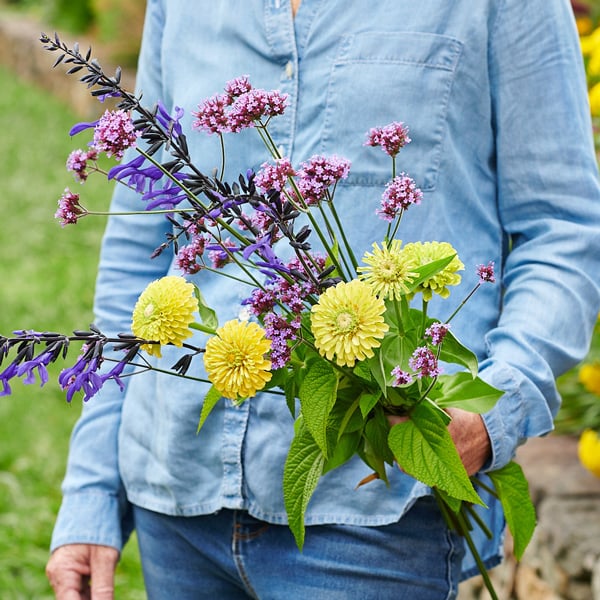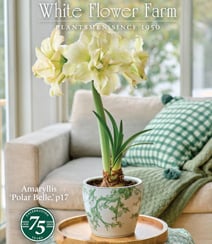How to Grow a Cut Flower Garden

PLAN
What is a Cutting Garden?
A cutting garden can be an area specifically designed for growing flowers and other botanicals for use in a variety of plant-based projects. It can also be part of an existing garden. Either way, the design of a cut flower garden will depend on the goals of the gardener.
When productivity is the priority, a designated area may be preferred. It may be a large space, with long rows and plants spaced closely for efficient care and large yields. Alternatively, it may be a few containers on the patio or an extra row in the veggie patch. No matter its shape or size, this kind of cutting garden has the chief purpose of being useful in arrangements and other items created from its contents – from casual bouquets and pressed flower art to formal corsages, memorial sprays, and wedding chuppahs.
Other gardeners may wish to intermingle plants for cutting with existing landscape plants for a garden that is meant for beauty in addition to use. The size of the harvest is not the main goal. Gardeners may tuck a few annuals into bare spots in an already established perennial garden, or they may plant shrubs with showy flowers or fruits among an evergreen foundation or hedge. Plants may provide occasional snips to fill vases, or bouquets to give friends, or they may be left alone to enhance the landscape, attract pollinators, and support wildlife.
Choosing Plants for Cut Gardens
Just as the designs of cutting gardens may vary greatly, so too can the kinds of plants they contain. First of all, they need not be limited to flowers. Blooms may be the stars of any cut flower garden, but foliage, fruits, seedpods, and branches can significantly augment floral designs. Secondly, the types of plants that are useful for cut gardens range from herbaceous annuals, biennials, and perennials to woody shrubs, vines, and trees. Finally, keep in mind that every season offers something to cut. From the earliest spring-flowering bulbs to winter’s assortment of evergreen boughs, branches, and berries, any cut flower enthusiast should make the most of the year-round possibilities.
Scroll below to see a wide array of plants we recommend for cutting gardens.
GROW
How to Start a Cut Flower Garden
Once you have an idea about the shape and scope of your cutting garden and the kinds of plants you wish to grow, there are some essential steps to take before and when you plant.
- Choose the right light: Select a place that has the proper light conditions needed by the plants you wish to grow. In most cases, you will want full sun (6 or more hours of direct sunlight per day) or partial sun (3-4 hours of direct sunlight per day). Certain perennials, such as Hellebores (Helleborus), prefer shade (little or no direct sunlight but some reflected light). For more information about light, click here.
- Prepare the ground: Most plants prefer loose, well-drained, nutrient-rich soil. We provide step-by-step instructions on how to turn and amend your soil.
- How to plant: If you are planting from seed, follow the instructions on the package. To plant bulbs, bareroot plants, or container-grown plants, please consult our planting instruction guide.
Basic Tips
We have a few recommendations to help you start a successful cut flower garden.
- Choose a variety of flowers with various bloom times so you have blossoms to cut all season long.
- Choose a variety of sizes, textures, and flower forms to provide interest.
- Select plants in a color palette that will make it easy to put flowers together to create a bouquet.
- Plant tallest varieties in the back row so they do not shade the others.
Caring for Your Cut Flower Garden
After planting, there are other plant care tasks to consider, such as watering, mulching, fertilizing, staking, deadheading, and pruning.
HARVEST
How to Cut Stems
It is best to cut flowers in the morning when temperatures are cool, since plants will become more dehydrated as the day gets warmer. It is also a good idea to carry a bucket of water to put stems into as soon as they are cut. (Leaving stems out of water increases the likelihood of air bubbles forming inside them, which can prevent the absorption of water.)
Use sharp, clean floral snips or scissors to cut stems (household scissors may crush stems, which prevents the uptake of water). Cut stems on a 45-degree angle so there is more surface area to absorb water and the cut end does not lay flush on the bottom of the bucket. For woody stems, make one or more vertical cuts into the base of the stem for water to penetrate more easily.
Gently strip foliage from any part of the stem that will be immersed in water. Leaves in the water will decompose quickly and make the vase water smell unpleasant.
How to Care for Cut Stems and Arrangements
Before you make an arrangement, it is important to condition your flowers and other cuttings. Stems should be freshly cut on an angle (see above) and placed in lukewarm water mixed with a floral preservative. Allow stems to hydrate for at least one hour before use. Keep cuts cool and out of direct sun.
Flower arrangements also require care. Be sure to replace the water in vases or containers every couple days so it is fresh and not cloudy. For stems that are losing vigor or starting to get soft or gummy, make a fresh cut at their ends. Dispose of any blooms or foliage that are wilting or spent to keep the other stems healthy longer. In general, keep arrangements out of direct sunlight. Misting your arrangements with water from a spray bottle may also help them remain fresh longer (this is especially true of evergreens).
Cutting and Care Tips for Select Plants
- Astilbe: The blooms are useful for cutting if they are picked when half-open. Dried flower heads may also be cut to add interesting structure and texture to late summer and autumn arrangements.
- Daffodil (Narcissus): Avoid combining cut Daffodils with other kinds of flowers since the stems exude a toxic sap. Daffodils prefer cold water, not lukewarm (as do other flowering bulbs).
- Dahlia: The stems of Dahlias are hollow. Be sure to provide plenty of clean water.
- Peony (Paeonia): Cut Peonies when the flower buds are in "marshmallow stage," or soft bud.
- Poppy (Papaver): Sear the ends of freshly cut stems with a match or dip in boiling water to seal in the milky sap.
Plants We Recommend for Cutting Gardens
Annual Flowers
- Ageratum
- Bachelor's Button (Centaurea)
- Calendula
- Cockscomb (Celosia)
- Cosmos
- Dahlia
- False Queen Anne's Lace (Ammi visnaga 'Green Mist')
- False Sunflower (Heliopsis)
- Flowering Tobacco (Nicotiana)
- Gladiola (Gladiolus)
- Globe Amaranth (Gomphrena)
- Ornamental Grass (multiple genera)
- Larkspur (Delphinium)
- Love-in-a-Mist (Nigella)
- Marigold (Tagetes)
- Mexican Sunflower (Tithonia)
- Poppy (Papaver)
- Queen Anne's Lace (Daucus carota 'Dara')
- Scabious (Scabiosa)
- Snapdragon (Antirrhinum)
- Statice (Limonium)
- Strawflower (Xerochrysum bracteatum or Bracteantha)
- Sweet Pea (Lathyrus)
- Tulip (Tulipa)
- Violet/Pansy (Viola)
- Zinnia
Perennial Flowers
Shrubs
- Deutzia
- Forsythia
- Hydrangea
- Lilac (Syringa vulgaris)
- Mock Orange (Philadelphus)
- Rose (Rosa)
- Sweet Pepperbush (Clethra alnifolia)
- Weigela
Foliage
- Arborvitae (Thuja)
- Astilbe
- Basil (Ocimum basilicum)
- Boxwood (Buxus)
- Coral Bells (Heuchera)
- Dusty Miller (Centaurea cineraria, Senecio)
- Elderberry (Sambucus)
- Eucalyptus
- Fern (multiple genera)
- Ornamental Grass (multiple genera)
- Lady's Mantle (Alchemilla mollis)
- Ninebark (Physocarpus opulifolius)
- Oregano (Origanum)
- Red-leaf Hibiscus (Hibiscus 'Mahogany Splendor')
- Scented Geranium (Pelargonium)
- Siberian Bugloss (Brunnera macrophylla)
- Spurge (Euphorbia)
- Weigela
Fruit
- Beautyberry (Callicarpa dichotoma)
- Crabapple (Malus)
- Dogwood (Cornus)
- Rose (Rosa)
- Snowberry/Coralberry (Symphoricarpos)
- Viburnum
- Winterberry (Ilex verticillata)
Seed heads & Seedpods
- Black-eyed Susan
- Coneflower
- Love-in-a-Mist
- Milkweed (Asclepias)
- Poppy
Stems & Branches
- Dogwood (Cornus sericea, C. stolonifera)
- Harry Lauder's Walking Stick (Corylus avellana 'Contorta')
- Willow (Salix)
- Astilbe
- Basil
- Black-eyed Susan
- Blazing Star
- Cockscomb
- Coneflower
- Eucalyptus
- Globe Amaranth
- Hydrangea
- Lavender
- Love-in-a-Mist
- Milkweek
- Oregano
- Poppy
- Statice
- Strawflower
- Yarrow
- Basil
- Bee Balm
- Colchicum
- Daffodil (select varieties)
- Eucalyptus
- Garden Phlox (Phlox paniculata)
- Hummingbird Mint
- Iris
- Korean Spice Viburnum (Viburnum carlesii)
- Lavender
- Lilac
- Lily
- Marigold
- Mock Orange
- Oregano
- Peony
- Rose
- Scented Geranium
- Sweet Peak
- Sweet Pepperbush
- Tulip
- Violet/Pansy
- Calendula
- Lavender
- Marigold
- Nasturtium (Tropaeolum)
- Violet/Pansy
OTHER USES
Plants for Drying
Plants for Fragrance
Edible Plants
SHOP ALL GARDEN PLANTS


